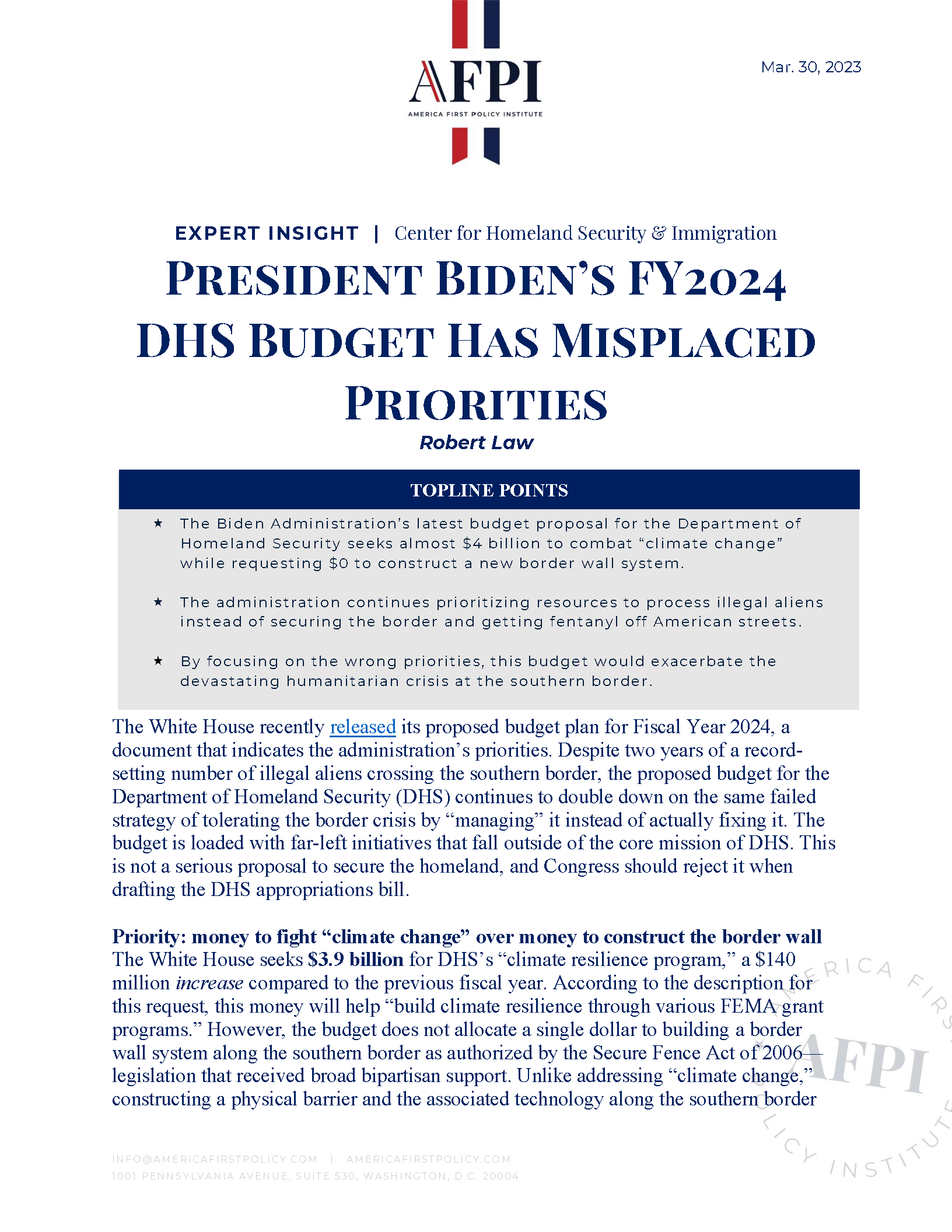President Biden’s FY2024 DHS Budget Has Misplaced Priorities
Key Takeaways
The Biden Administration’s latest budget proposal for the Department of Homeland Security seeks almost $4 billion to combat “climate change” while requesting $0 to construct a new border wall system.
The administration continues prioritizing resources to process illegal aliens instead of securing the border and getting fentanyl off American streets.
By focusing on the wrong priorities, this budget would exacerbate the devastating humanitarian crisis at the southern border.
The White House recently released its proposed budget plan for Fiscal Year 2024, a document that indicates the administration’s priorities. Despite two years of a record-setting number of illegal aliens crossing the southern border, the proposed budget for the Department of Homeland Security (DHS) continues to double down on the same failed strategy of tolerating the border crisis by “managing” it instead of actually fixing it. The budget is loaded with far-left initiatives that fall outside of the core mission of DHS. This is not a serious proposal to secure the homeland, and Congress should reject it when drafting the DHS appropriations bill.
Priority: money to fight “climate change” over money to construct the border wall
The White House seeks $3.9 billion for DHS’s “climate resilience program,” a $140 million increase compared to the previous fiscal year. According to the description for this request, this money will help “build climate resilience through various FEMA grant programs.” However, the budget does not allocate a single dollar to building a border wall system along the southern border as authorized by the Secure Fence Act of 2006—legislation that received broad bipartisan support. Unlike addressing “climate change,” constructing a physical barrier and the associated technology along the southern border would actually further the mission of DHS to protect the homeland. Spending $3.9 billion would produce more than 350 miles of new border wall system to help secure the border and disrupt the trafficking networks.
Priority: money for electric vehicles over money to combat the fentanyl public health emergency
Fentanyl is the leading cause of death for young Americans aged 18–45. The Mexican cartels are flooding American communities with fentanyl by exploiting the open border created by the Biden Administration’s failed border policies. Yet, the administration only requests $40 million to “combat fentanyl trafficking and disrupt transnational criminal organizations.” This sum is woefully insufficient, and, at the rate the federal government is currently spending taxpayer dollars, $40 million is equal to what the federal government spends in just 3.38 minutes. In comparison, the DHS budget seeks $123 million to “support market-shaping investments into Zero-Emission Vehicles.” Though the total is far lower than the “climate change” earmark, the administration is essentially saying that converting DHS vehicles to electric is three times more important than combatting the fentanyl-driven public health crisis.
Priority: money for processing illegal aliens over money for enforcing the law
The budget proposes creating a $4.7 billion “contingency fund” to help DHS respond to “migrant surges along the Southwest border.” This would be modeled after a fund in place for unaccompanied alien children that uses taxpayer dollars to provide food and shelter and process illegal aliens out of DHS custody. The plan seeks funding for an additional 460 “processing assistants” at U.S. Customs and Border Protection and U.S. Immigration and Customs Enforcement and $865 million for U.S. Citizenship and Immigration Services (USCIS) to process “an increasing asylum caseload.” However, USCIS is supposed to be fee-funded and not funded through taxpayer appropriations, so this particular request would inappropriately put taxpayers on the hook for a problem created by Biden Administration policies.
As the past two years have shown, simply managing a border crisis of this magnitude without introducing policies that deter illegal immigration and secure the border will fail. Although the administration uses vague labels like “Address the Situation at the Southwest Border” and “Enhances Border Security and Immigration Enforcement,” they serve only to obscure a continuation of the same failed strategy. And though the budget does seek funding for an additional 350 Border Patrol Agents, that number is noticeably fewer than the 460 “processing assistants” the budget is seeking. This budget would mean that new Border Patrol Agents will continue to be hampered by the same policies that prevent the existing ones from implementing their border security mandate.
